| |
|
|
|
Xerox > Digital Xerox
Xerox 510 | 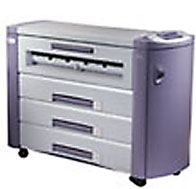 | Although the 510 has what can best be described as a "checkered past," it is in reality a "pretty good little box." Conceived by "Mother X" and the Xerox engineers in Rochester the 510 ended up in a political squabble and was sent to Japan for manufacture by Fuji Xerox. Fuji took one look at the box and said "not invented here. After wandering in limbo for better than a year while Xerox dealers sold what ever they could get their hands on, "Mother X" in her infinite wisdom decided to bring the little 510 dp home. It is now being "produced" for Xerox under contract by a company in Huntsville, AL. there have been substantial startup up quality problems which we understand are "being worked out."
The 510 dp is an innovative system. It can be ordered with or field upgraded from a one roll system to a two or three roll printer. In addition the 510 dp has field upgrade - downgrade capability to switch output capacity from five, seven or ten "D" size prints per minute. This makes the 510 dp a powerful point of use printer with a huge amount of flexibility.
Xerox's decision to marry the 510 dp printer with its Synergix scanner and the PLP inspired Access controller has yielded an effective mid range system. Their brilliant idea of offering a "color Synergix scanner option" for a black and white printer was off the chart. Most people will never effectively use the color scanner but it adds thousands of dollars in revenue to their bottom line. A word to the wise, don't buy the color scanner in less you can really cost justify the added expense.
This is a short run product for Xerox and will probably go out of production sometime in early 2006. The shots in wide format at Xerox are now being called by Fuji Xerox out of Japan and the 510 is obviously not made in Japan. The 510 dp is a good short term investment with very little upward migration path. |
| [−] |
|
Xerox 6030-6050 |  | This machine is so bad that most of the Xerox dealers in the country have elected not to sell it. The system was designed by Fuji Xerox as a six copy and nine copy per minute solution. It simply does not meet American standards. At its best, which is not good, the machine functions as a wide format copier. It will make multiple copies and reduce and enlarge but the steps required to produce a copy are clumsy and not at all intuitive. In its plotter mode, the machine is at best adequate. The hang up is that in plot mode the output speed is cut in about half. The ultimate debacle is encountered when the 6050/6030 is installed in its "Scan to File" configuration. The explanation give for this is that the systems components are incompatible and that they simply have difficulty talking to each other. In addition to the systems problems this unit has, the purchaser must contend with a machine that is mostly plastic. The 6050/6030 is rated for a monthly output of 4,500 square feet. At this rate it is doubtful if the system will be able to last for the production of 100,000 square feet of copy.
In short, do yourself a favor and stay away from this machine. Shame on you Mother X. |
| [−] |
|
Xerox 721 | 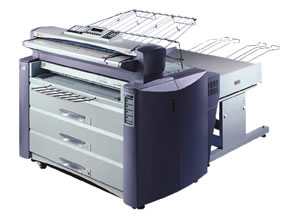 | Oh for the days when this once proud company (Xerox) actually made something, besides hot air. The print engine for the 721 p is in reality a KIP 8000. The KIP 8000 is presently the fastest wide format printer in the world. It is robust and easy to maintain. Operating costs are low and print quality is excellent. The controller for the 721 p is made by PLP which is good solid technology. The Synergix scanner is a Xerox product and congratulations Xerox, you got this one right. |
| [−] |
|
Xerox 8825 | 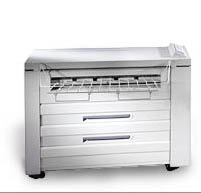 | This is the "little brother" of the 8830 family. The principal differences are that Xerox slowed the output speed of the printer from six to four "D" size prints per minute by installing an interrupter that shuts the print function down for a few seconds between prints. This was purely a move to differentiate and de-feature the product. The 8825 family has the option of one or two rolls of media as apposed to the three roll capacity of the 8830. In all other respects the 8825 and the 8830 are twins. As with the 8830, the 8825 is the "home grown" digital print engine from "Mother X." Xerox took their "finest hour," the 3050 analog copier, and turned it into a one or two roll digital plotter. Initially introduced as a stand alone plotter the "boys from Rochester" married a modified Vidar scanner to the printer which gave them scan to print capability. They have dubbed this the 8825 DDS (for Digital Document System). A button panel on the scanner allows the operator to perform the engineering copier functions of reduction and enlargement and multiple copy. Archiving of scanned images is accomplished using a "scan to network" feature in which the scanned images is transferred to a folder on the network for printing from a system computer. Some users find this "scan to network" feature clumsy when compared with the "scan to file" capability of the KIP and Oce' products.
In its later manifestations Xerox has ditched the Vidar scanner and replaced it with their own Xerox manufactured, Synergix scanner, which is a "world class" product. Their AccXES controller and software was developed by PLP and appears to be stable and productive.
The 8825 and the 8830 have been replaced by the new 510. Xerox has had huge manufacturing difficulties with 510. Due to these problems the 510 is in shot supply. As a result many Xerox dealers are resurrecting their 8825 and 8830 machines and selling them as used equipment until the 510 becomes readily available. |
| [−] |
|
Process / Imaging
|
Xerographic LED
|
|
Photoreceptor
|
Organic
|
|
Media Supply
|
1 or 2 Rolls, 500' with cut sheet by-pass
|
|
Media Type
|
Bond, Vellum and Film
|
|
Output Size
|
Min. 8-1/2" x 11", Max. 36" x 80'
|
|
Processes Speed
|
3 ips
|
|
Throughput
|
4 D's per minute
|
|
Power Requirements
|
60 Hz; 115 V/ 16A, 50-60 Hz; 220/230-240
V/10A
|
|
Weight
|
Aprox. 550 lbs
|
|
Dimensions
|
W 57" x H 43" x D 23"
|
|
Finishing
|
Standard - Catch Tray - 50 E / 100 D
Optional - Online folder
Optional - Stacker 1000 - up to 1000
mixed prints
|
Controller (Early Versions)
|
CPU
|
Power PC 603e, 200MHz
|
|
Memory
|
64 MNb, SDRAM Expandable to 128 Mb
|
|
Hard disk
|
Standard 2.2 Gb Ultra SCSI; 7200 RPM
Internal Drive
|
|
Maximum Length
|
80' Printing, 100' copying
|
|
Data Formats
|
CGM, HP-GL/HP-Gl2, HP-RTL, CalComp
906/907/951/PCI, TIFF 6, NIRS, CALS I & II, Versatec,
Raster, VDS, CCITT G4 (all color formats converted to gray
scale)
|
|
Interfaces
|
VPI, SCSI-2; Bi-directional Centronics;
optional internal Ethernet card supports10 BaseT, 10 Base 2
(future support for 100 BaseTX
|
|
Network Protocals
|
TCP/IP with lpr/pd, Novell IPX/SPX PS
Server 3.1/4.1 with NDS; Ethertalk; NetBEUI
|
|
Client Software
|
ADI Print Drivers for AutoCAD R12, R13,
and R14 (without raster);Print Drivers for Windows
3.11/NT/95; Printer Manager Tool for Windows
3.11/NT/95;Document Submission Tool for Widows 3.11/NT/95;
document Retrieval Tool for Windows NT/95; Print Manager/
Document Submission tool for Sun Solaris
|
Controller (AccXES)
|
CPU
|
Power PC 7400, 200MHz
|
|
Power
|
110 / 220V
|
|
Memory
|
64 MNb, SDRAM Expandable to 192 Mb
|
|
Hard Disk
|
Standard 9.1 Gb Ultra Wide SCSI; 7200
RPM Internal Drive
|
|
Data Formats
|
HP-GL/HP-Gl2, HP-RTL, CGM (Level 1 with
ATA ext.); C4 fileNET, XES 150 Emulation; Versatec Data
Standards (VRF, ordered vector, blocked raster, compacted
raster), CalComp 906/907/951/PCI, TIFF 6.0, CALS I & 2, VCGL;
Compression types (for applicable raster formats); CCITT
G4, G3-1D, G3-2D, Packbits, RLE, Seed Row, Adaptive;
Optional Adobe PostScript 3 with PDF support
|
|
Interfaces
|
Standard - Serial RS-232, IEEE 1284
Bi-directional Centronics; Ultra wide SCSI; VIP; 10/100
Ethernet (TCP/IP) supports 10/100 BaseT, Optional - External
print server
|
|
Network Protocals
|
Standard - TCP/IP with lpr/lpd
Optional - Novell, Ethertalk, NetBEUI and
others supported through external print server
|
|
Client Software
|
ADI and HDI Print Drivers for AutoCAD
R14, AutoCAD 2000 and 2000i
Print drivers for Windows 95/98/2000/NT
Web Printer Manager Tool using Netscape
Navigator 4 or Microsoft IE 4 or later
Document Submission Tool for Windows
95/98/2000/NT and Solaris
Optional - Adobe PostScript 3 drivers for
Windows 95/98/2000/NT
|
Scanner
|
Resolution
|
200 or 400 dpi
|
|
Copy/Scan Speed
|
Up to 3 ips
|
|
Image Scan
|
36" x 100' Max., 4-1/2" x 5-1/2" Min.
|
|
Document Handeling
|
Standard Large Document Handling system;
automatic centering of image on output media
|
|
7356 Power Requirement
|
100 - 120/240 V, 60/50Hz, 3 amps
|
Copier Mode
|
AutoIQ
|
Automatic background suppression and
width detection of original
|
|
Job Currency
|
Scanning, copying, printing and printer
interrupt key
|
|
Sets Build
|
Electronic collation; forward and
reverse; last scan replacement; rescale and reprint without
rescanning; 999 copies from a set of 100 standard E-size
drawings.
|
|
Reduction and Enlargement
|
25 to 400% in 0.1% increments
|
|
Output Selection
|
Auto/manual roll selection and scaling to
output media
|
|
Store and Recall
|
Recall image data and parameters from
last copy job; can save and recall 10 user parameter
settings
|
|
Xerox 8825 DDS | 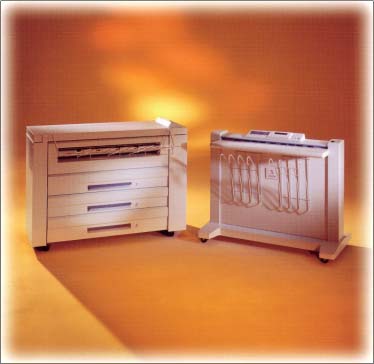 | This is the "little brother" of the 8830 family. The principal differences are that Xerox slowed the output speed of the printer from six to four "D" size prints per minute by installing an interrupter that shuts the print function down for a few seconds between prints. This was purely a move to differentiate and de-feature the product. The 8825 family has the option of one or two rolls of media as apposed to the three roll capacity of the 8830. In all other respects the 8825 and the 8830 are twins. As with the 8830, the 8825 is the "home grown" digital print engine from "Mother X." Xerox took their "finest hour," the 3050 analog copier, and turned it into a one or two roll digital plotter. Initially introduced as a stand alone plotter the "boys from Rochester" married a modified Vidar scanner to the printer which gave them scan to print capability. They have dubbed this the 8825 DDS (for Digital Document System). A button panel on the scanner allows the operator to perform the engineering copier functions of reduction and enlargement and multiple copy. Archiving of scanned images is accomplished using a "scan to network" feature in which the scanned images is transferred to a folder on the network for printing from a system computer. Some users find this "scan to network" feature clumsy when compared with the "scan to file" capability of the KIP and Oce' products.
In its later manifestations Xerox has ditched the Vidar scanner and replaced it with their own Xerox manufactured, Synergix scanner, which is a "world class" product. Their AccXES controller and software was developed by PLP and appears to be stable and productive.
The 8825 and the 8830 have been replaced by the new 510. Xerox has had huge manufacturing difficulties with 510. Due to these problems the 510 is in shot supply. As a result many Xerox dealers are resurrecting their 8825 and 8830 machines and selling them as used equipment until the 510 becomes readily available. |
| [−] |
|
Process / Imaging
|
Xerographic LED
|
|
Photoreceptor
|
Organic
|
|
Media Supply
|
1 or 2 Rolls, 500'
with cut sheet by-pass
|
|
Media Type
|
Bond, Vellum and Film
|
|
Output Size
|
Min. 8-1/2" x 11",
Max. 36" x 80'
|
|
Processes Speed
|
3 ips
|
|
Throughput
|
4 D's per minute
|
|
Power Requirements
|
60 Hz; 115 V/ 16A,
50-60 Hz; 220/230-240 V/10A
|
|
Weight
|
Aprox. 550 lbs
|
|
Dimensions
|
W 57" x H 43" x D 23"
|
|
Finishing
|
Standard - Catch Tray
- 50 E / 100 D
Optional - Online
folder
Optional - Stacker
1000 - up to 1000 mixed prints
|
Controller (Early Versions)
|
CPU
|
Power PC 603e, 200MHz
|
|
Memory
|
64 MNb, SDRAM
Expandable to 128 Mb
|
|
Hard disk
|
Standard 2.2 Gb Ultra
SCSI; 7200 RPM Internal Drive
|
|
Maximum Length
|
80' Printing, 100'
copying
|
|
Data Formats
|
CGM, HP-GL/HP-Gl2,
HP-RTL, CalComp 906/907/951/PCI, TIFF 6,
NIRS, CALS I & II, Versatec, Raster, VDS,
CCITT G4 (all color formats converted to
gray scale)
|
|
Interfaces
|
VPI, SCSI-2;
Bi-directional Centronics; optional
internal Ethernet card supports10 BaseT,
10 Base 2 (future support for 100 BaseTX
|
|
Network Protocals
|
TCP/IP with lpr/pd,
Novell IPX/SPX PS Server 3.1/4.1 with
NDS; Ethertalk; NetBEUI
|
|
Client Software
|
ADI Print Drivers for
AutoCAD R12, R13, and R14 (without
raster);Print Drivers for Windows
3.11/NT/95; Printer Manager Tool for
Windows 3.11/NT/95;Document Submission
Tool for Widows 3.11/NT/95; document
Retrieval Tool for Windows NT/95; Print
Manager/ Document Submission tool for
Sun Solaris
|
Controller (AccXES)
|
CPU
|
Power PC 7400, 200MHz
|
|
Power
|
110 / 220V
|
|
Memory
|
64 MNb, SDRAM
Expandable to 192 Mb
|
|
Hard Disk
|
Standard 9.1 Gb
Ultra Wide SCSI; 7200 RPM Internal
Drive
|
|
Data Formats
|
HP-GL/HP-Gl2, HP-RTL,
CGM (Level 1 with ATA ext.); C4 fileNET,
XES 150 Emulation; Versatec Data
Standards (VRF, ordered vector, blocked
raster, compacted raster), CalComp
906/907/951/PCI, TIFF 6.0, CALS I & 2,
VCGL; Compression types (for applicable
raster formats); CCITT G4, G3-1D,
G3-2D, Packbits, RLE, Seed Row,
Adaptive; Optional Adobe PostScript 3
with PDF support
|
|
Interfaces
|
Standard - Serial
RS-232, IEEE 1284 Bi-directional
Centronics; Ultra wide SCSI; VIP; 10/100
Ethernet (TCP/IP) supports 10/100 BaseT,
Optional - External print server
|
|
Network Protocals
|
Standard - TCP/IP
with lpr/lpd
Optional - Novell,
Ethertalk, NetBEUI and others supported
through external print server
|
|
Client Software
|
ADI and HDI Print
Drivers for AutoCAD R14, AutoCAD 2000
and 2000i
Print drivers for
Windows 95/98/2000/NT
Web Printer Manager
Tool using Netscape Navigator 4 or
Microsoft IE 4 or later
Document Submission
Tool for Windows 95/98/2000/NT and
Solaris
Optional - Adobe
PostScript 3 drivers for Windows
95/98/2000/NT
|
Scanner
|
Resolution
|
200 or 400 dpi
|
|
Copy/Scan Speed
|
Up to 3 ips
|
|
Image Scan
|
36" x 100' Max.,
4-1/2" x 5-1/2" Min.
|
|
Document Handeling
|
Standard Large
Document Handling system; automatic
centering of image on output media
|
|
7356 Power
Requirement
|
100 - 120/240 V,
60/50Hz, 3 amps
|
Copier Mode
|
AutoIQ
|
Automatic background
suppression and width detection of
original
|
|
Job Currency
|
Scanning, copying,
printing and printer interrupt key
|
|
Sets Build
|
Electronic collation;
forward and reverse; last scan
replacement; rescale and reprint without
rescanning; 999 copies from a set of 100
standard E-size drawings.
|
|
Reduction and
Enlargement
|
25 to 400% in 0.1%
increments
|
|
Output Selection
|
Auto/manual roll
selection and scaling to output media
|
|
Store and Recall
|
Recall image data and
parameters from last copy job; can save
and recall 10 user parameter settings
|
|
Xerox 8830 | 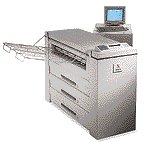 | Originally code named "Rhino", as in Rhinoceros, the 8830 is the "home grown" digital print engine from "Mother X." Xerox has taken their "finest hour", the 3050 analog copier, and turned it into a three roll digital plotter. Initially introduced as a stand alone plotter the "boys from Rochester" married a modified Vidar scanner to the printer which gave them scan to print capability. They have dubbed this the 8830 DDS (for Digital Document System). A button panel on the scanner allows the operator to perform the engineering copier functions of reduction and enlargement and multiple copy. Archiving of scanned images is accomplished using a "scan to network" feature in which the scanned images are transferred to a folder on the network for printing from a system computer. Some users find this "scan to network" feature clumsy when compared with the "scan to file" capability of the KIP and Oce' products.
In its later manifestations Xerox has ditched the Vidar scanner and replaced it with their own Xerox manufactured, Synergix scanner which is a "world class" product. Their AccXES controller and software was developed by PLP and appears to be stable and productive.
The 8825 and the 8830 have been replaced by the new 510. Xerox has had huge manufacturing difficulties with 510. Due to these problems the 510 is in short supply. As a result many Xerox dealers are resurrecting their 8825 and 8830 machines and selling them as used equipment until the 510 becomes readily available. |
| [−] |
|
Process / Imaging
|
Xerographic LED
|
|
Photoreceptor
|
Organic
|
|
Media Supply
|
3 Rolls, 500' with cut sheet by-pass
|
|
Media Type
|
Bond, Vellum and Film
|
|
Output Size
|
Min. 8-1/2" x 11", Max. 36" x 80'
|
|
Processes Speed
|
3 ips
|
|
Throughput
|
Up to 7 D's per minute
|
|
Power Requirements
|
60 Hz; 115 V/ 16A, 50-60 Hz; 220/230-240
V/10A
|
|
Weight
|
Aprox. 575 lbs
|
|
Dimensions
|
W 57" x H 43" x D 23"
|
|
Finishing
|
Standard - Catch Tray - 50 E / 100 D
Optional - Online folder
Optional - Stacker 1000 - up to 1000
mixed prints
|
Controller (Early Versions)
|
CPU
|
Power PC 7400, 200MHz
|
|
Memory
|
64 MNb, SDRAM Expandable to 192 Mb
|
|
Hard disk
|
Standard 2.2 Gb Ultra SCSI; 7200 RPM
Internal Drive
|
|
Maximum Length
|
80' Printing, 100' copying
|
|
Data Formats
|
CGM, HP-GL/HP-Gl2, HP-RTL, CalComp
906/907/951/PCI, TIFF 6, NIRS, CALS I & II, Versatec,
Raster, VDS, CCITT G4 (all color formats converted to gray
scale)
|
|
Interfaces
|
VPI, SCSI-2; Bi-directional Centronics;
optional internal Ethernet card supports10 BaseT, 10 Base 2
(future support for 100 BaseTX
|
|
Network Protocals
|
TCP/IP with lpr/pd, Novell IPX/SPX
PSServer 3.1/4.1 with NDS; Ethertalk; NetBEUI
|
|
Client Software
|
ADI Print Drivers for AutoCAD R12, R13,
and R14 (without raster);Print Drivers for Windows
3.11/NT/95; Printer Manager Tool for Windows
3.11/NT/95;Document Submission Tool for Widows 3.11/NT/95;
document Retrieval Tool for Windows NT/95; Print Manager/
Document Submission tool for Sun Solaris
|
Controller (AccXES)
|
CPU
|
Power PC 7400, 200MHz
|
|
Power
|
110 / 220V
|
|
Memory
|
64 MNb, SDRAM Expandable to 192 Mb
|
|
Hard Disk
|
Standard 9.1 Gb Ultra Wide SCSI; 7200
RPM Internal Drive
|
|
Data Formats
|
HP-GL/HP-Gl2, HP-RTL, CGM (Level 1 with
ATA ext.); C4 fileNET, XES 150 Emulation; Versatec Data
Standards (VRF, ordered vector, blocked raster, compacted
raster), CalComp 906/907/951/PCI, TIFF 6.0, CALS I & 2, VCGL;
Compression types (for applicable raster formats); CCITT
G4, G3-1D, G3-2D, Packbits, RLE, Seed Row, Adaptive;
Optional Adobe PostScript 3 with PDF support
|
|
Interfaces
|
Standard - Serial RS-232, IEEE 1284
Bi-directional Centronics; Ultra wide SCSI; VIP; 10/100
Ethernet (TCP/IP) supports 10/100 BaseT, Optional - External
print server
|
|
Network Protocals
|
Standard - TCP/IP with lpr/lpd
Optional - Novell, Ethertalk, NetBEUI and
others supported through external print server
|
|
Client Software
|
ADI and HDI Print Drivers for AutoCAD
R14, AutoCAD 2000 and 2000i
Print drivers for Windows 95/98/2000/NT
Web Printer Manager Tool using Netscape
Navigator 4 or Microsoft IE 4 or later
Document Submission Tool for Windows
95/98/2000/NT and Solaris
Optional - Adobe PostScript 3 drivers for
Windows 95/98/2000/NT
|
Scanner
|
Resolution
|
200 or 400 dpi
|
|
Copy/Scan Speed
|
Up to 3 ips
|
|
Image Scan
|
36" x 100' Max., 4-1/2" x 5-1/2" Min.
|
|
Document Handeling
|
Standard Large Document Handling system;
automatic centering of image on output media
|
|
7356 Power Requirement
|
100 - 120/240 V, 60/50Hz, 3 amps
|
Copier Mode
|
AutoIQ
|
Automatic background suppression and
width detection of original
|
|
Job Currency
|
Scanning, copying, printing and printer
interrupt key
|
|
Sets Build
|
Electronic collation; forward and
reverse; last scan replacement; rescale and reprint without
rescanning; 999 copies from a set of 100 standard E-size
drawings.
|
|
Reduction and Enlargement
|
25 to 400% in 0.1% increments
|
|
Output Selection
|
Auto/manual roll selection and scaling to
output media
|
|
Store and Recall
|
Recall image data and parameters from
last copy job; can save and recall 10 user parameter
settings
|
|
Xerox 8850 | 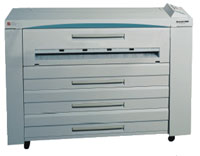 | The 8850 is a further evolution of the tried and true Xerox 3050 print engine. At ten "D" size prints per minute, the 8850 is a speeded up version of the "time proven, tried and true" 8830. By coupling the Xerox manufactured Synergix scanner with their own software and AccXES controller the 8850 has the opportunity to be a "heavy duty player" in the upper end of the mid-range market. |
| [−] |
|
Process / Imaging
Photoreceptor
Media Supply
Media Type
Output Size
Resolution
Process Speed
Throughput
Power Requirements
Weight
Dimensions
Finishing
Safety Certifications
|
Xerographic LED
Organic
3 Rolls, 500 ft; Cut sheet
bypass
Bond, Vellum and Film
Min 8 inches x 11 inches
Max 36 inches x 80 ft
standard 400dpi
4.5 ips
Up to 10 D's / 5 E's per
minute
60 Hz: - 208 - 240 - VAC/20A
50-60 Hz: 220 - 240 - VAC/16A
Approx. 625 lbs
W 57" H 43" D 23"
Standard - Catch Tray - 100
prints
Optional - Online Folder
Optional - Stacker 1000 - up
to 1000 mixed size prints
UL 1950, CNL C22.2 No.
950-M93, Low Voltage Directive 72/23/EEC, CE Marking
Directive 93/68/EEC, FCC Part 15 Subpart B (Class A),
ICES-003, Issue 3: 1997 (Class A), EMC Directive 89/366/EEC
|
Resolution
Copy / Scan Speed
Input
Edge/Center
Adjustment
Scan-to-Net
Client Software
Power Requirements
Dimensions
Safety Certifications
|
400 x 400 dpi
4 ips at 400 dpi (copy and
scan)
8 ips at 200 dpi (scan)
Min 4 inches x 5 inches
Max 42 inches x 100 ft (only
captures 36 inches of image)
Thick documents up to inch
Lead and trail edge adjust /
center alignment
Standard; Indexing; Scan
preview; Ling to raster editor; Resolution selection; TIFF
6.0, CALS or PDF data format; TCP/IP Ethernet interface;
Line or grayscale modes
Document Retrieval Tool for
Windows 95/98/2000/NT and Solaris
50/60 Hz; 120/240 V; 10A
W 53" H 45" D 16" with stand
UL 1950, CNL C22.2 No.
950-M93, Low Voltage Dirctive 72/23/EEC, CE Marking
Directive 93/68/EEC, FCC part 15 Subpart B (Class A),
ICES-003, Issue 3: 1997 (Class A), EMC Directive 89/366/EEC
|
AccXES
Controller
|
|
Copier
|
|
|
CPU
Power
Memory
Hard Disk
Data Formats
Interfaces
Network Protocols
Client Software
|
Power PC 740, 200 MHz
110/220 V
64 Mb standard, Expandable
to 192 Mb
Standard - 9.1 Gb Ultra Wide
SCSI, 7200 rpm, Internal drive
HP-GL; HP-GL/2; HP-RTL; CGM
(Level 1 with ATA ext.); C4; FileNET; XES 150 Emulation;
Versatec Data Standards (VRF, ordered vector, blocked
raster; compacted raster); CalComp 906/907/951/PCI; TIFF
6.0; NIRS; CALS 1 & 2; VCGL; Compression types (for
applicable raster formats): CCITT G4, G3-1D, G3-2D,
Packbits, RLE, Seed Row, Adaptive
Optional Adobe PostScript 3
with PDF Support
Standard - Serial RS-232,
IEEE 1284 Bi-directional
Centronics; Ultra wide SCSI;
VPI;
10/100 Ethernet
(TCP/IP) supports 10/100
Base T
Optional - External print
server
Standard - TCP/IP with lpr/lpd
Optional - Novell, Ethertalk,
NetBEUI and others supported through external print server
ADI and HDI print drivers
for
AutoCAD R14, AutoCAD 2000 &
2000I
Print drivers for Windows
95/98/2000/NT
Web Printer Manager Tool
using Netscape Navigator 4 or Microsoft IE 4 or later
Document Submission Tool for
Windows 95/98/2000/NT and Solaris
Optional - Adobe PostScript
3 drivers for Windows 95/98/2000/NT
|
Reduction/Enlargement
Output Selection
Concurrency
Digital Retention
Sets Build
Imaging
Image Quality
Copy Modes
|
25 to 400% in 0.1%
increments
Auto/manual roll selection
and scaling
Scanning/copying/printing;
Printer interrupt key
Up to 999 copies from a set
of at least 100 standard E size drawings
Electronic collation;
Forward; Reverse; Last job recall; Rescale and reprint
without rescanning; 999 copies; Batch mode
Inverse, Mirroring;
Transform; Rotation; 7 copy contrast levels
Automatic dynamic background
suppression / Automatic width detection of original
Line; Mixed; Photo
|
Options
External Print
Server, Expandable Memory to 192 MB, Adobe PostScript 3 (includes
PDF support), Stacker 1000, Online Folder, Compact scanner catch
tray
Features
Auto port
sensing, Auto data format recognition, Auto scaling, Auto rotation,
Auto size detection, Auto roll select and switch , Remote printer
administration, Prioritized job queuing, Remote job queue
management, Electronic collation, 9 pen palettes (256 pens each), 64
pen patterns, including 15 user-definable patterns, Plot labeling
with automatic naming and time/date generation, Banner pages, Page
composition/plot overlay, Plot stamping with user-downloadable
stamps, 10 user setups, 256 grayscales, Media mismatch management,
Plot nesting.
|
Xerox 8850 DDS |  | The 8850 is a further evolution of the tried and true Xerox 3050 print engine. At ten "D" size prints per minute, the 8850 is a speeded up version of the "time proven, tried and true" 8830. By coupling the Xerox manufactured Synergix scanner with their own software and AccXES controller the 8850 has the opportunity to be a "heavy duty player" in the upper end of the mid-range market. |
| [−] |
|
Process / Imaging
Photoreceptor
Media Supply
Media Type
Output Size
Resolution
Process Speed
Throughput
Power Requirements
Weight
Dimensions
Finishing
Safety Certifications
|
Xerographic LED
Organic
3 Rolls, 500 ft; Cut sheet
bypass
Bond, Vellum and Film
Min 8 inches x 11 inches
Max 36 inches x 80 ft standard
400dpi
4.5 ips
Up to 10 D's / 5 E's per minute
60 Hz: - 208 - 240 - VAC/20A
50-60 Hz: 220 - 240 - VAC/16A
Approx. 625 lbs
W 57" H 43" D 23"
Standard - Catch Tray - 100
prints
Optional - Online Folder
Optional - Stacker 1000 - up to
1000 mixed size prints
UL 1950, CNL C22.2 No. 950-M93,
Low Voltage Directive 72/23/EEC,
CE Marking Directive 93/68/EEC,
FCC Part 15 Subpart B (Class A),
ICES-003, Issue 3: 1997 (Class
A), EMC Directive 89/366/EEC
|
Resolution
Copy / Scan Speed
Input
Edge/Center
Adjustment
Scan-to-Net
Client Software
Power Requirements
Dimensions
Safety Certifications
|
400 x 400 dpi
4 ips at 400 dpi (copy and scan)
8 ips at 200 dpi (scan)
Min 4 inches x 5 inches
Max 42 inches x 100 ft (only
captures 36 inches of image)
Thick documents up to inch
Lead and trail edge adjust /
center alignment
Standard; Indexing; Scan
preview; Ling to raster editor;
Resolution selection; TIFF 6.0,
CALS or PDF data format; TCP/IP
Ethernet interface; Line or
grayscale modes
Document Retrieval Tool for
Windows 95/98/2000/NT and
Solaris
50/60 Hz; 120/240 V; 10A
W 53" H 45" D 16" with stand
UL 1950, CNL C22.2 No. 950-M93,
Low Voltage Dirctive 72/23/EEC,
CE Marking Directive 93/68/EEC,
FCC part 15 Subpart B (Class A),
ICES-003, Issue 3: 1997 (Class
A), EMC Directive 89/366/EEC
|
|
AccXES Controller
|
|
|
|
|
CPU
Power
Memory
Hard Disk
Data Formats
Interfaces
Network Protocols
Client Software
|
Power PC 740, 200 MHz
110/220 V
64 Mb standard, Expandable to
192 Mb
Standard - 9.1 Gb Ultra Wide
SCSI, 7200 rpm, Internal drive
HP-GL; HP-GL/2; HP-RTL; CGM
(Level 1 with ATA ext.); C4;
FileNET; XES 150 Emulation;
Versatec Data Standards (VRF,
ordered vector, blocked raster;
compacted raster); CalComp
906/907/951/PCI; TIFF 6.0; NIRS;
CALS 1 & 2; VCGL; Compression
types (for applicable raster
formats): CCITT G4, G3-1D,
G3-2D, Packbits, RLE, Seed Row,
Adaptive
Optional Adobe PostScript 3 with
PDF Support
Standard - Serial RS-232, IEEE
1284 Bi-directional
Centronics; Ultra wide SCSI; VPI;
10/100 Ethernet
(TCP/IP) supports 10/100 Base T
Optional - External print server
Standard - TCP/IP with lpr/lpd
Optional - Novell, Ethertalk,
NetBEUI and others supported
through external print server
ADI and HDI print drivers for
AutoCAD R14, AutoCAD 2000 &
2000I
Print drivers for Windows
95/98/2000/NT
Web Printer Manager Tool using
Netscape Navigator 4 or
Microsoft IE 4 or later
Document Submission Tool for
Windows 95/98/2000/NT and
Solaris
Optional - Adobe PostScript 3
drivers for Windows
95/98/2000/NT
|
Reduction/Enlargement
Output Selection
Concurrency
Digital Retention
Sets Build
Imaging
Image Quality
Copy Modes
|
25 to 400% in 0.1% increments
Auto/manual roll selection and
scaling
Scanning/copying/printing;
Printer interrupt key
Up to 999 copies from a set of
at least 100 standard E size
drawings
Electronic collation; Forward;
Reverse; Last job recall;
Rescale and reprint without
rescanning; 999 copies; Batch
mode
Inverse, Mirroring; Transform;
Rotation; 7 copy contrast levels
Automatic dynamic background
suppression / Automatic width
detection of original
Line; Mixed; Photo
|
Options
External
Print Server, Expandable Memory to 192 MB,
Adobe PostScript 3 (includes PDF support),
Stacker 1000, Online Folder, Compact scanner
catch tray
Features
Auto port
sensing, Auto data format recognition, Auto
scaling, Auto rotation, Auto size detection,
Auto roll select and switch , Remote printer
administration, Prioritized job queuing,
Remote job queue management, Electronic
collation, 9 pen palettes (256 pens each),
64 pen patterns, including 15 user-definable
patterns, Plot labeling with automatic
naming and time/date generation, Banner
pages, Page composition/plot overlay, Plot
stamping with user-downloadable stamps, 10
user setups, 256 grayscales, Media mismatch
management, Plot nesting.
|
Xerox 8855 | 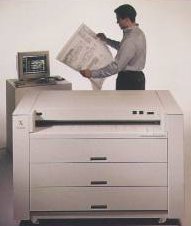 | The 8855 is in reality a KIP print engine, originally introduced with a KIP high-speed scanner and PLP software. The unit was later sold with a Vidar scanner and ultimately with their own Synergix scanner and proprietary AccXES controller and software. There are new, faster printers (KIP 8000 series) that are becoming available that will force this system into retirement as a front line product, but the 8855 is still good solid second tear technology and possibly the best bang for the buck in the market today, if you don't have to have the latest and greatest. |
| [−] |
Specifications
8855 Printer
Process /
Imaging
Photoreceptor
Media Supply
Media Type
Output Size
Resolution
Process Speed
Throughput
Power
Requirements
Weight
Dimensions
Finishing
AccXES
Controller
CPU
Memory
Hard Disk
Data Formats
Interfaces
Network
Protocols
Client
Software
Power
|
Xerographic
LED
Organic
4 Rolls, 500
ft; manual sheet bypass
Bond, Vellum,
Film
Min 8 x 11
inches
Max 36 inches
x 20 feet
400 dpi
6.3 ips
Up to 13 D /
7 E per minute
50/60 Hz
single phase;
220-240 VAC;
16 Amp
Approx. 880
lbs
W 54" H 37" D
39"
Standard -
Catch Tray-50 E/100D
Optional -
Online Folder
Optional -
High Capacity Stacker
Power PC 740
64 Mb
standard; expandable up to 192 Mb
Standard - 9
Gb Ultra Wide SCSI, 7200 rpm, internal drive
HP-GL;
HP-GL/2; HP-RTL; CGM (Level 1 with ATA ext);
C4; File NET; Versatec Data Standards (VRF,
ordered vector, blocked raster, compacted
raster); CalComp 906/907/951/PCI; TIFF 6.0;
NIRS; CALS 1 & 2; VCGL; compression types
(for applicable raster formats): CCITT G4,
G3-1D, G3-2D, Packbits, RLE, Seed Row,
Adaptive; Optional Adobe PostScript 3 with
PDF support
Standard -
Serical RS-232; IEEE 1284 Bi-directional
Centronics; Ultra wide SCSI; VPI; 10/100
Ethernet (TCP/IP) supports 10/100 Base T
Optional -
External Print Server
Standard -
TCP/IP with lpr/lpd.
Optional -
Novell, Ethertalk, NetBEUI and others
supported through external print server
ADI drivers
for AutoCAD R13/14 and AutoCAD 2000
Print Drivers
for Win 95/98/2000/NT Web Print Manager Tool
using Netscape Navigator 4 or Microsoft IE 4
or later Document Submission Tool for Win
95/98/2000/NT Document Retrieval Tool for
Win 95/98/2000/NT
Optional -
Adobe PostScript 3 Drivers for Win
95/98/2000/NT
110/220 V
|
7356
Scanner
Resolution
Copy/Scan
Speed
Input
Edge / Center
Adjustment
Scan-to-Net
Power
Requirements
Copier
Reduction /
Enlargement
Output
Selection
Concurrency
Digital
Retention
Sets Build
Imaging
Auto IQ
Copy Modes
|
400 x 400 dpi
3 ips at 400
dpi (copy and scan) 4.67 ips at 300 dpi
(scan) 6 ips at 200 dpi (scan)
Min 4 x 5
inches
Max 41 inches
x 100 feet (only will capture 36" of image)
Lead and
trail edge adjust / center alignment
Indexing;
scan preview; link to raster editor;
resolution selection; RIFF 6.0 or CALS data
format; TCP/IP Ethernet interface; line or
grayscale modes
50/60 Hz;
120/240 V; 10 A
25 to 400% in
0.1% increments
Auto/Manual
Roll Selection and Scaling
Scanning/Copying/Printing; Printer Interrupt
Key
Upt ot 999
copies from a set of at least 100 standard E
size drawings
Electronic
Collation; Forward; Reverse; Last job
recall; Rescale and Reprint without
Rescanning; 999 copies
Inverse;
Mirroring; Transform; Rotation; 7 copy
contrast levels
Automatic
Background Suppression / Width detection of
original
Line; Mixed;
Photo
|
Auto port sensing, Auto
data format recognition, Auto scaling, Auto rotation,
Auto size detection, Auto roll select and switch, Remote
printer administration, Prioritized job queuing, Remote
job queue management, Electronic collation, 9 pen
palettes (256 pens each), 64 pen patterns, including 15
user-definable patterns, Plot labeling with automatic
naming and time/date generation, Banner pages, Page
composition / plot overlay, Plot stamping with
user-downloadable stamps, 10 user setups, 256 gray
scales, Media mismatch management, Plot nesting, Account
data tracking, Scan-to-Net
External Print Server,
Expandable Memory to 192 Mb, Adobe PostScript 3
(includes PDF support), High Capacity Stacker, Online
Folder
|
Xerox Max 200 | 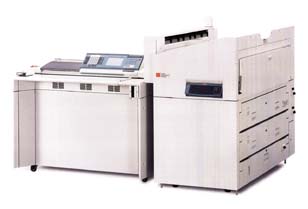 | This machine is bad news all the way around. Xerox took the Fuji developed 8180 which was a twenty-four inch output, redline machine. The 8180 would print black and red at sixty feet per minute. They spliced a one foot section in the printer, slowed it down to forty feet a minute and tried to market the machine against the Oce' 9800. The machine turned out to be "service hog," it requires almost perpetual maintenance. The end user might live with this except that Xerox only trained a few techs to service the machine which resulted in extensive down time and the eventual cancellation of the product. |
| [−] |
|
|
|
|
405-488-7292
P.O. Box 14469 Oklahoma City, Oklahoma 73113
[email protected]
|
|
|


